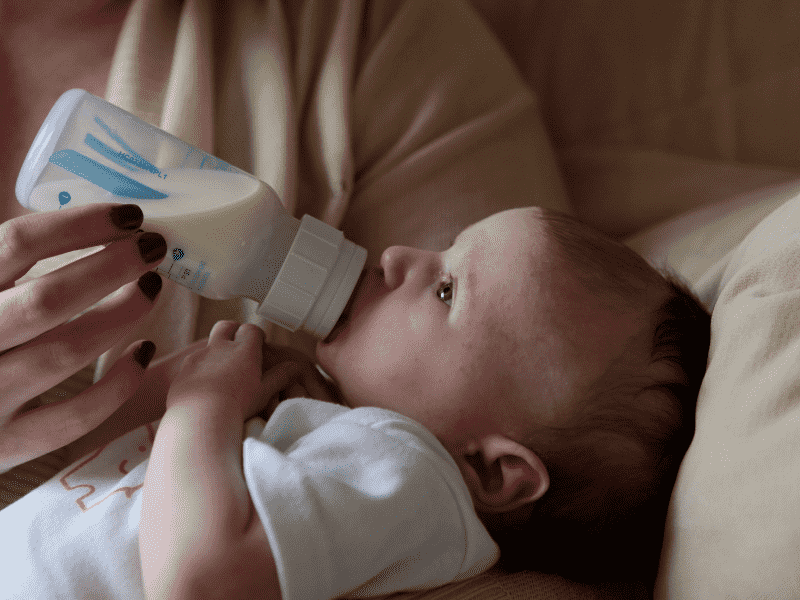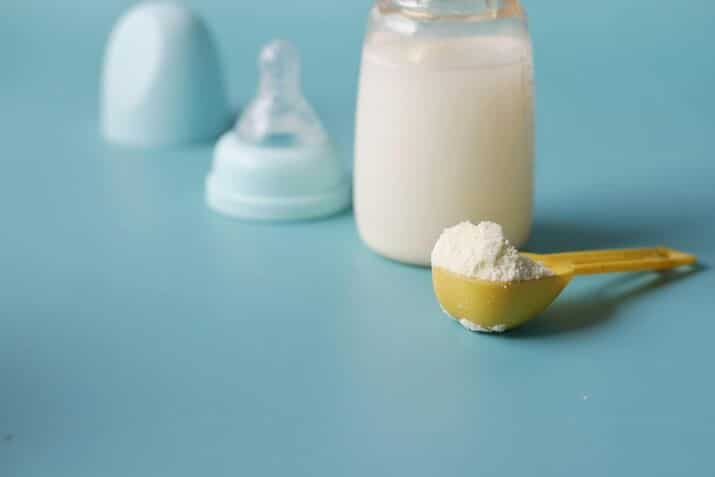Lactose free formula is infant formula made without lactose, the natural milk sugar found in breast milk and most standard formulas. Some babies digest lactose with no trouble. Others struggle during or after tummy bugs, or because lactase activity is low for a while. This option swaps lactose for other carbohydrates so feeds feel gentler while still supporting growth. It is also different from products made for milk protein allergy or sensitivity, which focus on the protein side rather than the carbohydrate side. If symptoms are strong or do not settle, speak with your pediatrician before switching so the plan fits your baby’s needs.
What lactose means for babies
Lactose is a carbohydrate that provides energy and helps the body absorb minerals like calcium. Babies use an enzyme called lactase to digest it. When lactase drops because of illness or other temporary reasons, the gut can feel gassy and unsettled. That discomfort sometimes looks similar to reactions caused by milk proteins like whey and casein, so families often wonder which issue they are dealing with.
It helps to separate three ideas. True infant lactose intolerance is rare and involves very low lactase levels. Milk protein allergy is an immune reaction to milk proteins. Milk protein sensitivity is a non-allergic response that still causes digestive upset. These conditions need different solutions. If protein is the driver, changing only the carbohydrate will not fix the problem. If lactose is the issue, choosing a product that removes lactose can help.
Who Needs Lactose Free Formula
Babies recovering from a stomach bug sometimes have temporary trouble with lactose. A few have ongoing difficulty digesting it and feel better when lactose is removed. Lactose free formula for babies is built for these situations. The goal is steady calories, good growth, and a calmer tummy while the cause is assessed and managed.
The signs that families often track include frequent gas, loose stools, fussiness during or after feeds, and a pattern that lines up with volumes. As these signs are not specific, consultation with a pediatrician helps minimize guesswork. During a trial of lactose-free formula, maintain constant conditions. Use a single water source, follow the stated mixing ratio, and allow a consistent trial window before judging the effect.

What replaces lactose in lactose free formula milk
When a label says lactose free formula, the carb source is different. Instead of lactose, brands often use glucose polymers or corn-based carbohydrates. These don’t need lactase to digest, so they may reduce tummy discomfort in babies who struggle with lactose. Each formula uses its own mix to keep energy level and taste close to regular formula, while keeping osmolarity in a safe range. Parents often ask about sweetness, stools, and gas when carbohydrate sources change. Texture and tolerance vary by baby. The most helpful practice is simple and steady, track feeds and diapers, keep the bottle routine the same each day, and allow a few days before deciding whether a product fits.
Why protein still matters even when you switch carbs
Many families focus on the word lactose and miss the protein side. Protein type shapes comfort too. Cow’s milk protein can be intact, partially hydrolyzed, or extensively hydrolyzed. Goat milk has a different casein pattern and can form a different curd. If a baby reacts to milk protein, removing lactose will not solve it. In that case, your clinician may suggest a product with hydrolyzed protein or a different protein source.
This is why a careful history helps. Note whether fussiness shows up with every feed or mainly at higher volumes. Note skin rashes, blood in stools, or other warning signs. Bring these notes to your visit so your care team can decide whether the path is carbohydrate change, protein change, or both.
Why Iron Fortified Matters on the Label
You will see claims like iron fortified formula milk, iron fortified formula, or formula fortified with iron across many tins. Iron supports normal development. It is not related to lactose digestion. Even if you choose a baby formula lactose free option, iron still appears on the label because babies need it. Some parents worry iron will upset the tummy. Most babies do well with the standard level. If your baby seems uncomfortable, discuss it with your pediatrician rather than guessing. Sometimes the cause is volume, speed of feeds, or bottle setup rather than iron itself.
Newborn needs and toddler needs
Stage choice keeps nutrition matched to age. Lactose free newborn formula supports the earliest months with small, frequent feeds and a simple nutrient picture. As energy demands change, lactose free toddler formula is designed for later stages with different volumes and supporting nutrients. Always check the stage on the tin. Mixing ratios and scoop sizes can change by product, so read the instructions each time you open a new brand or stage. Use clean bottles, measure water first, then powder, and shake well until no clumps remain.
What organic lactose free formula means
Many families value ingredient sourcing. Organic lactose free formula means the carbohydrate and protein sources follow organic standards. It does not change the medical meaning of lactose free. It also does not treat allergy on its own. Think of it as a sourcing preference layered on top of your feeding needs. If the nutrition profile matches your baby and your pediatrician agrees, you can choose an organic version with confidence.
Choosing the right lactose free formula for your baby
Picking the right lactose free formula starts with a clear goal, less tummy discomfort and steady growth, then a quick check of stage, protein, and carbohydrate. Match the stage to age first, such as lactose free newborn formula for early months. Look at the protein type next, because comfort depends on more than lactose removal; some babies do better with partially or extensively hydrolyzed protein if protein sensitivity is part of the picture. Finally, scan the carbohydrate blend used in lactose free formula milk, since brands choose different lactose replacements that digest at different speeds.
Keep the rest simple: pick one product that fits your clinician’s advice, use it consistently for a fair trial window, and watch the big signs that matter—feeds taken, diapers, sleep, and general comfort—rather than reacting to one feed or one diaper. If the trial shows calmer feeds and good energy progress is likely on the current tin; if not, notes can be recorded and options reviewed with a pediatrician, including a protein change or a stage adjustment.
Tracking comfort and deciding what comes next
Once baby formula lactose free, give the body time to settle and judge progress over several days, not hours. A plain notebook or phone note works well, recording the number of feeds, typical volumes, stool patterns, gas, and mood before and after feeds. If you see a steady trend toward easier feeds and better sleep, stay the course. If discomfort remains high or other signs appear, such as skin rashes or mucus or blood in stools, pause and speak with your clinician, because that pattern points to a protein issue rather than a lactose issue.
Baby food & nutrition with a formula plan
Baby food and nutrition choices sit alongside formula. For many months, formula remains a major source of calories even after solids begin. When solids are added, consider iron sources, hydration, and allergy safety. Keep the same label-reading habits for snacks and purées as for a tin of formula. If a child has shown sensitivity to certain proteins, scan ingredient lists carefully and introduce new foods in a clear, simple pattern so reactions can be spotted. A steady daily rhythm helps. Plan feeds and meals so they do not compete.
Gentle feeding habits that reduce stress
Babies read our mood. Calm, predictable habits make feeds smoother. Hold your baby in a comfortable, supported position. Watch for early hunger cues instead of waiting for strong crying. Pace the bottle so swallowing looks relaxed. Offer breaks to burp. Keep the environment simple during feeds so the focus stays on eating. Afterward, give a few quiet minutes before active play. These small habits help any plan, including one that uses lactose free formula milk or a protein-adjusted option.
How to gentle-troubleshoot common concerns
If stools look different after a switch, give a few days before you decide to stop. If gas seems worse, check bottle flow and pacing. If sleep patterns wobble, adjust the evening routine first. When in doubt, call your pediatrician and share your notes. The aim is steady growth and a baby who looks comfortable across the day. A thoughtful plan plus close observation usually leads to a stable choice.
Quick Decision Paths with Your Clinician
If symptoms began after a recent stomach bug, your clinician may suggest a short trial of formula lactose free while the gut recovers. If there are rashes, blood in stools, or strong distress, the first step is a protein-focused discussion rather than a lactose change. When growth is steady and symptoms are mild, small routine tweaks might be tried before switching tins. If your family prefers organic sourcing and the nutrition profile fits your child, organic lactose free formula can be part of the plan with your pediatrician’s approval. These ideas are planning prompts for your visit, not medical instructions; your care team knows your child and will tailor steps safely.
FAQs
Is organic lactose free formula better than non-organic?
- Better depends on your values and your baby’s needs. Organic speaks to sourcing standards. Comfort, tolerance, and growth guide the final call.
What is the difference between lactose free toddler formula and the newborn version?
Stage, serving sizes, and supporting nutrients. Follow the stage on the label and the mixing instructions that go with it.
How do baby food & nutrition choices change once solids start?
Formula remains central for a long time. Add solids step by step, focus on iron sources, and keep hydrate habits steady. Keep reading labels with the same care you use for a formula tin.
Conclusion
Feeding choices feel simpler when you sort lactose questions from protein questions, match the right stage to age, and keep prep steady. With a clear plan, careful notes, and your pediatrician’s guidance, you can find a comfortable fit whether you stay with a standard product or move to a tin that removes lactose. Focus on calm routines, accurate mixing, and steady observation rather than quick switches. Small, consistent steps lead to better comfort, easier feeds, and happy growth.



